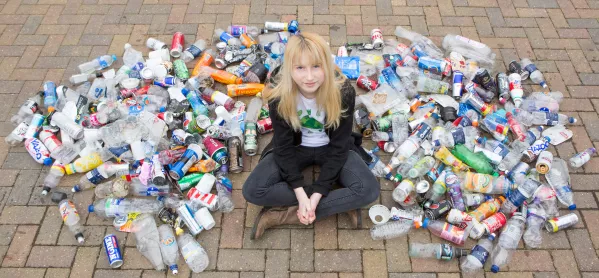Trash Girl: the hero we need this Earth Day

Nadia Sparkes is a perfectly ordinary 12-year-old schoolgirl from Norwich. Except, that is, when she’s being Trash Girl, collecting litter on her way home from school as part of a mission to protect the environment.
Nadia began clearing up plastic rubbish and bringing it home in her bike basket after realising just how much there was on her two-mile journey to school. She decided to see how much she could collect by the end of her first term at secondary school, even though she was called “Trash Girl” and was bullied for her efforts.
Her mother told her she had two choices: stop collecting rubbish and drawing attention to herself, or embrace Trash Girl. Deciding the name made her sound like a superhero, Nadia pressed on. “I’m not going to stop doing the right thing because of them,” she says. “If they’re going to call me ‘Trash Girl’, they can say it with respect. I’m doing something to protect the world they also live in.” She and her parents have since set up a Facebook page, Team Trash Girl, which now has 3,500 members; she’s inspired other children to collect rubbish, had a cartoon character drawn for her - and she’s now one of the youngest Earth Hour Ambassadors for WWF UK. The bullying has stopped.
While Nadia’s story is unusual, her enthusiasm for sustainability and the environment isn’t. There’s a whole generation of children who are growing up recycling at home, and learning about energy use, pollution and climate change through environmental education at school. Proactive teachers also weave the environment into other areas of the curriculum - outdoor story-telling; biology through seed growing; maths through measuring and constructing spaces.
And plenty of those schools, too, are putting extra-curricular eco-projects at the top of their agenda. Ysgol San Siôr in Llandudno, Wales, one of WWF’s Green Ambassador schools, sells eggs from chickens kept on site, and vegetables tended by its primary-aged pupils. Heald Place, in Greater Manchester, has an allotment, orchard and wild garden, clawed back from abandoned land nearby.
Harnessing children’s innate interest in nature to do something about the environment is the next logical step. Nurturing a child such as Nadia, a proactive individual with a clear mission and the get-up-and-go to “crack on”, is a great way to embed a school’s environmental motivation and show other children they can make a difference.
Hellesdon High School, where Nadia is in Year 7, has publicised her efforts and invited fellow pupils to join her crusade to pick up three pieces of litter every day. It’s also reinforced messages about bringing reusable water bottles into school and has bolstered the number of recycling bins on-site.
Cherry Duggan, WWF’s head of schools and youth relations, says: “Through our Green Ambassadors scheme, schools tell us how children are the driving force, with endless ideas and a totally hands-on approach. It really lifts the spirits to hear how teachers are not only fully involving their pupils in environmental and sustainability projects but often being led by their interests.”
She says encouraging children to make a Promise for the Planet as part of WWF’s Earth Hour is a good first step to get them to think about what they can do as individuals, not just part of a school community.
Eleanor Walker, WWF’s Green Ambassador Teacher of the Year 2016, always wants to hear ideas from the children at Victoria Park Primary in Bristol. As the Eco Schools leader, Walker is full of admiration for Trash Girl. “She’s a great role model. The older pupils in Year 5 and 6 wanted to mentor the younger ones on green issues and what they can do to help. They set up sessions where they updated the Year 3 and 4 children and talked about eco issues together. I love that it was entirely their idea.” Another child at her school made hair scrunchies out of old clothes. “She came up with that on her own, and I’m delighted that the values we’ve instilled are so embedded in the children that they can act creatively. If they can come up with a realistic idea, we can help them make it happen,” she stresses.
Ensuring sustainability is embedded at primary level can often lead to confident older children striking out on their own when they reach secondary school in the way that Nadia has, says Ian Jones, head of Ysgol San Siôr. He remembers a former pupil getting in touch about a KS3 project on the rainforest. “He’d meticulously researched the impact of buying packaged sandwiches every day over making them at home. He’d thought about everything - farming, packaging, water consumption and energy use - independently. I was chuffed to bits.” Interestingly, this particular child hadn’t shown much enthusiasm for eco-issues at primary school. “Sometimes when you plant a seed, it doesn’t take immediately. But it usually shoots later on,” smiles Jones.
Teachers such as Walker and Jones want the flexibility to be able to run with an idea dreamed up by a pupil. “Children have a natural curiosity about the world, and schools which don’t nurture that are missing a trick,” says Jones. “Sometimes amazing things happen when you let them take the reins.”
Download the WWF Earth Hour taster activity here and register your school for Earth Hour to download the fantastic range of free resources for KS2 and KS3 pupils that are available. These include a teacher support pack, assembly presentation, animal fact sheets and creative activity sheets to help you and your pupils celebrate Earth Hour.
Earth Hour is on Saturday 24 March. Join millions round the globe as they turn out the lights for an hour from 8.30pm and make your own personal #PromiseForThePlanet.
